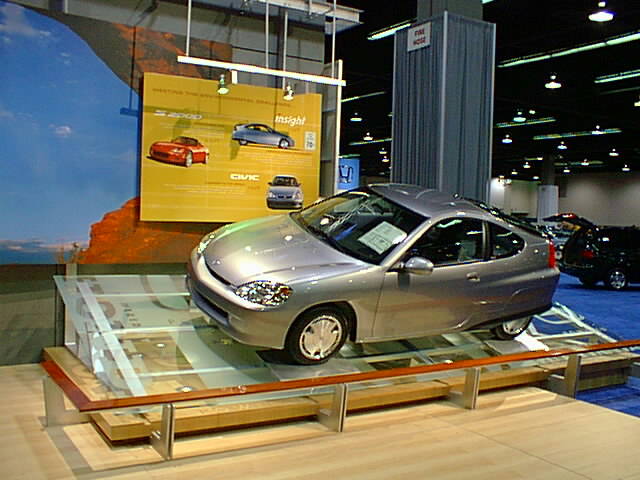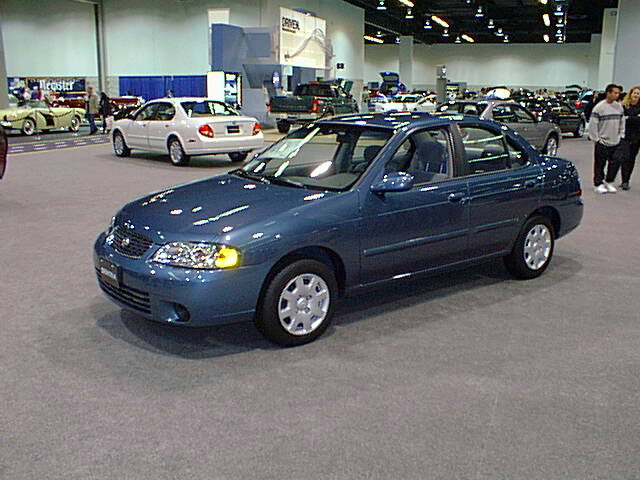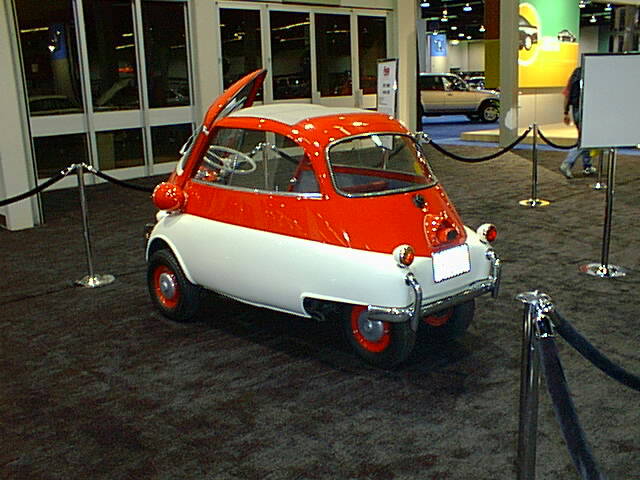
Home - AFV Events - Auto Shows - 2001 Anaheim Auto Show
At last year's California International Auto Show in Anaheim, I got my first look at the 2000 model-year Honda Insight, the first hybrid-electric vehicle sold in the United States; there was an area called the Millennium Pavilion where this and a large variety of other alternative-fueled vehicles were on display. Given last year's emphasis on this topic, I have to think that this year either I missed something (I spent only a short time at the show on Wednesday 8 November 2000 after work, since that was the only time I could go), or else alternative fuels have become so "mainstream" that they are unremarkable, and don't need any special display! The only alternative-fueled vehicles I saw were those that are currently available (with long waiting lists!) from dealers: the Insight and Toyota Prius hybrids, and the General Motors EV1 battery-electric car.

The Insight was on display in the Honda area, of course; you can see on the poster behind it that Honda did boast a little about it, along with the S2000 and the natural-gas-powered Civic GX. In the driving report I posted after renting an Insight from EV Rental Cars several months ago, I remarked that this was the only electric vehicle I've ever driven that had a manual transmission; well, for the 2001 model year the Insight is also available with a continuously-variable automatic transmission, which should help stick-shift klutzes like me to get a bit better fuel economy out of the beast!

This is the Nissan Sentra GXE; it is not an alternative-fueled vehicle, so why am I posting a photo of it on this website? Well, in September 2000 the California Air Resources Board (CARB) reaffirmed the Zero Emission Vehicle (ZEV) mandate, which requires 10% of 2003 and later model-year vehicles sold in California by six large-volume and eleven intermediate-volume automakers to have zero tailpipe emissions. In response to automaker protests that they were being frog-marched into a future for which the technology was not yet commercially viable, CARB has significantly watered down the requirement from its initial form as proposed a decade ago. Besides abandoning phase-in requirements that would have begun in the 1998 model year, and granting extra credits for early introduction of ZEVs and for battery-powered electric vehicles with long ranges per recharge, CARB now will allow the large-volume automakers to meet 6%, and the intermediate-volume automakers all 10%, of the requirement by getting credits for making and selling "Partial ZEVs" (PZEVs). These are vehicles with very low (but not zero) tailpipe emissions that also have zero evaporative emissions, offer a 150,000-mile emissions warranty, and meet some other requirements; I show a photo of the 2001 Sentra GXE because the California version of this gasoline-powered car is the first vehicle to be certified as a PZEV. The second, and so far only other, vehicle so certified is, not surprisingly, the Honda Civic GX that I mentioned above, which remains the cleanest internal-combustion-engine car you can buy. There are other internal-combustion vehicles, notably the Insight and Prius, that should be certifiable as PZEVs by 2003; I understand that the biggest hurdle is getting the reliability of the emission-control systems up to the 150,000-mile level! This is why battery-electric vehicles remain the "gold standard" for clean air--they don't get dirtier over time, but instead get cleaner as the generating stations from which they recharge are improved, or even replaced with renewable energy sources. Still, cleaner internal-combustion vehicles, including gasoline-powered ones, are certainly not bad news!

I mentioned at top that I only saw three alternative-powered vehicles at this show; in particular, the flex-fuel Ford Ranger, which could run on any mixture of gasoline and E85 (up to 85% ethanol) at no extra charge if buyers chose the 3.0-liter V6 engine, has been discontinued. (I understand that this will become the standard engine on most variants of the Taurus in a month or so, however, and that a flex-fuel 4.0-liter V6 is available for the Explorer Sport and Sport Trac.) I didn't see the E85 version of the four-cylinder Chevrolet S-10, though it is definitely available (by special order), and the flex-fuel Dodge Caravan is still "49-state" (i.e., not certified for sale in California, or other states that have adopted its emissions requirements). My old friend the EV1 was there in the Saturn display, though (a NiMH advanced-battery example), despite the fact that there is no 2001 model of the car (yet...?); the original (1997) cars that started coming off their leases in the last year or so will be refurbished, fitted with improved lead-acid batteries, and re-leased starting in a few months, and there is already a tremendous waiting list! Personally, though the EV1 remains my favorite car of all time, I am hoping to be able to buy a four-seat "family-car" version, like some of the concept cars that GM has shown, in 2003 or 2004: the lovely lady sitting in the car is Cheryl Kuroda, with whom I hope to be sharing vehicles (and everything else!) starting in about a year...

As at last year's edition of this auto show, the Petersen Automotive Museum had several vehicles on display. This is a 1957 BMW Isetta, a "micro-car" with about a 250cc (that's 0.25 liter!) engine; you can see that the trait shared by the Insight and EV1 of having the rear wheels closer together than the front ones is not a modern innovation! This and other micro-cars like the three-wheel Messerschmidt Kabinenroller ("Cabin Scooter") were the hallmarks of post-WWII economies that couldn't afford to waste money on needless fuel consumption. A "Did You Know?" note in the auto show program observed that the three most popular vehicles sold in Japan in 1999 were mini-cars with under 600cc (0.6 liter) engines; though that country today is a lot wealthier than it or Germany were after WWII, nonetheless gasoline prices of $4 per gallon and climbing are making people think about conservation more and more seriously. Even in the United States, with prices at about 40-50% of that level, people are starting to pay attention to fuel economy again after the fat days of the SUV in the nineties. One nice thing about modern alternative-powered vehicles is that, with advanced technology and cleaner, cheaper alternative fuels, it's not necessary to drive a "martyr-mobile" (in the words of EV1 enthusiast Marvin Rush) if you want to benefit your planet and your wallet!
 Back
to AFV Events Page
Back
to AFV Events Page Back
to Fueling Station
Back
to Fueling Station Site
Map
Site
Map Contact
Me
Contact
Me All content copyright 1998-2024 by Mark Looper, except as noted. Reuse of my copyrighted material is authorized under Creative Commons Attribution 4.0 International license (CC BY 4.0).
![]()
![]()
new 13 November 2000, revised 15 November 2000